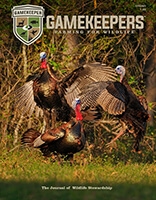When you begin to hunt and manage your property for wild turkeys, it doesn’t take long to discover that wild turkeys are among the most amazing creatures in all creation. Whether your region boasts Eastern wild turkeys, Rios, or any other species, managing their habitat is crucial to their success in your area. Habitat reduction due to urban sprawl is a real problem that is crowding some populations into other areas or reducing habitat altogether. This makes managing for wild turkeys more important now than ever.
Property that is properly managed for wild turkeys will provide cover and sustenance throughout the year. It is possible to create a turkey haven that will help your population thrive without breaking the bank. Developing a sustainable plan will keep you on track to creating the perfect property for turkeys.
Don’t be fooled into thinking that all your improvements must occur at once to see results. In fact, whenever you are farming for wildlife, land and habitat improvements should be ongoing. It is also important to note that your efforts during one particular season will likely have carryover effects into the next season and beyond. Immediate impact is not essential. It’s the long-term impact that matters.
The first step in creating a spread that will benefit your turkeys in all seasons is to set goals for each season. Make a list of all the land and habitat improvements you’ve already made. Follow that by listing improvements you would like to make or shortcomings you have identified in past improvements.
Focus on feeding options, nesting areas, water availability, and roosting. Let’s consider some turkey habitat improvements that can be completed during each season of the year. Since a wild turkey’s habitat range consists of hundreds of acres, the more you can do to provide your flock with its every need, the closer to your property they are going to stay.

Jarrod Stephens
Spring
Springtime is perhaps the most important season for habitat improvement. This is because the beginning of all flocks is a successful nesting season. Without a successful hatch, your numbers will be slow to improve. Allowing field edges to remain overgrown and carrying out timber stand management practices that enhance vegetation growth on the forest floor will help to promote successful hatches.
For turkey hunters, springtime provides a clear picture of the turkey population on their properties. The spring mating season puts the social behaviors of wild turkeys on full display. Having open areas for toms to mingle with hens is important because hens will likely nest near areas where their basic food, shelter, and watering needs are met. If there are no open fields on your property, identify locations that can be cleared for planting clover, chufa, or wheat plots.
As poults begin to hatch, the importance of cover and bugging areas increases. Poults are especially vulnerable to predators during the first few weeks of life when they are unable to fly. Insects make up a large part of a poult’s diet, which makes weedy fields perfect bugging locations that also provide cover. In fact, bugs will make up nearly 80% of a poult’s diet during its first couple of weeks. The protein in insects is critical for growth as well as feather and muscle development. Within three weeks, the poults can fly into trees to roost on low branches with the hen, offering added protection from predators. Having cover near feeding areas, or cover that produces feeding options, will allow more poults to survive. Avoid mowing every field, and allow field and woodland edges to become overgrown with woody stubble and weeds. Winter wheat stands that are maturing can provide both food and cover if left unmowed.
Planting annual crops such as soybeans or field corn in the spring is a step toward success during the fall and winter months. Both plot options require months to mature, so your spring plantings will be beneficial later in the year. Standing corn and soybeans provide excellent feeding options and cover during pivotal fall and winter months when natural food begins to get scarce. Wildlife will also feast on soybeans throughout the summer. Devoting at least a portion of your plot land to one or both of these grains is important. Planting wildflower plots that will mature in late summer and fall will provide bugging habitat along with seeds for consumption after the growing season.
Summer
During the summer months, don’t be tempted to mow all the roughage that has grown near field edges or timberlines. Such thickets can become prime locations for turkeys to seek shelter near food sources during the hottest months. Blackberries and other wild berries will ripen and provide excellent soft mast for turkeys.
Turkeys also love a place where they can dust, so using a disc to disturb the soil and expose bare ground will provide an excellent spot for them to dust and relax. Dusting is part of a turkey’s feather maintenance, and sometimes you’ll see large groups relaxing and dusting together.
It’s impossible to consider year-round habitat improvement without discussing water availability. If your property has a stream or other flowing water source, make sure that there are minimal disturbances to the surrounding vegetation. Buffer zones of at least fifty feet should be maintained when making improvements near running streams to prevent silt runoff. Trees and shrubs should remain undisturbed near stream edges, as they provide cover for turkeys while watering. Turkeys also love the grit found in many streams and will often spend hot days near the water’s edge.
As the heat turns up and your plots begin to mature, summer is also a great time to work on timber stand improvements. Creating hinge cuts for cover for the next nesting season while leaves are still on the trees can create thick ground-level cover. You can easily see the results of hack-and-squirt tree removal when employed during the summer. Simply cutting into the undesired tree with a hatchet in two or three spots and applying herbicide will effectively kill the tree without using a saw. As these understory trees die, more sunlight will reach the forest floor, creating greater cover diversity.

Jarrod Stephens
Fall
The end of your region’s growing season is the perfect time for mowing edges and untilled areas used for nesting and cover in the spring. Bush hogging or mowing prevents these areas from becoming too dense and promotes vigorous growth the following spring.
Fall is also an excellent time for planting winter wheat. The tender blades are perfect for feeding during winter months. Once spring nesting and hatching occur, the standing wheat becomes a favorite hangout for hens and poults, as the seed heads provide food and the tall wheat provides cover.
Much like deer, turkeys love when the nuts begin to hit the ground each fall. They will turn the forest floor upside down to uncover acorns, beechnuts, and other seeds. Managing areas to enhance mast production from oaks and other nut-bearing trees is important. Removing non-mast-bearing trees allows more nutrients to be absorbed by mast-bearing trees, which can lead to better production. Creating forest openings where nuts are easily found provides great feeding for turkeys during this time.

Jarrod Stephens
Winter
If your region experiences harsh winters, adequate thermal cover is essential. Protect or even expand your conifer stands by planting more. The thick branches create an understory of protection and help keep the ground beneath more open and accessible. The branches also provide excellent roosting. Younger forests, particularly on south-facing slopes, create a dense understory that provides a break from brutal winds. Plots such as switchgrass or other native warm-season grasses offer vertical structure that acts as windbreaks during severe weather.
If you have field corn plots, consider mowing strips to knock grain to the ground where turkeys can forage. Avoid mowing the entire plot so that cover remains available. You can repeat mowing as necessary to provide sustained food sources.
Access to water during winter months is another concern, especially during harsh weather. Creating a pond is important if flowing streams are not present on your property. Protecting areas around natural springs and seeps can provide water when other sources are frozen.
Conclusion
Managing your property for wild turkeys is not a single event or improvement. You must be a forward thinker and envision the results of your efforts. True management is ongoing, with improvements and preparations for the season to come. We can’t control what each season will bring, but we can prepare our land to meet the needs of our turkey population. Turkeys don’t get days off, and every day is a matter of survival. Each improvement you make today will impact the future of your flock for years to come.
-
Join our weekly newsletter or subscribe to Gamekeepers Magazine.
Your source for information, equipment, know-how, deals and discounts to help you get the most from every hard-earned moment in the field.









